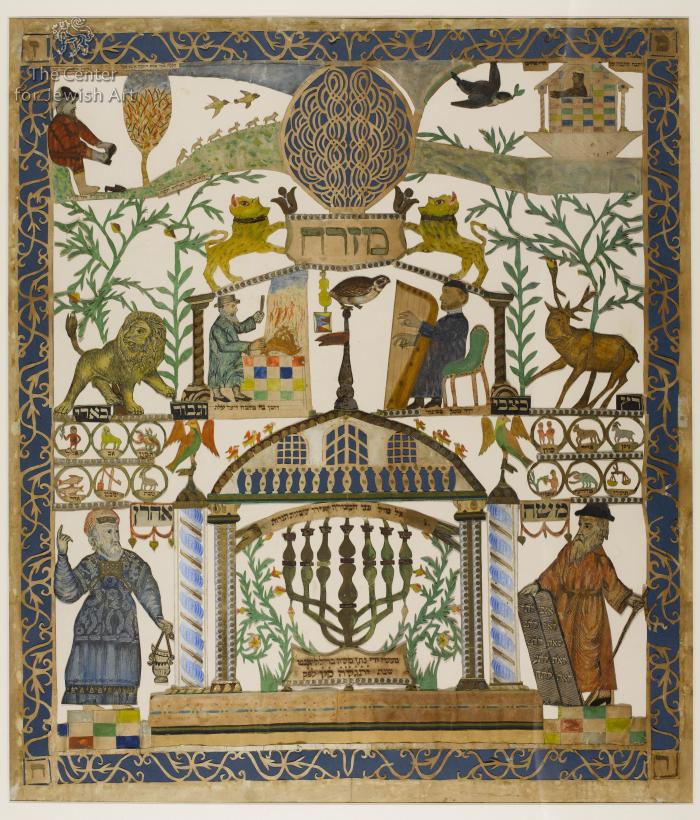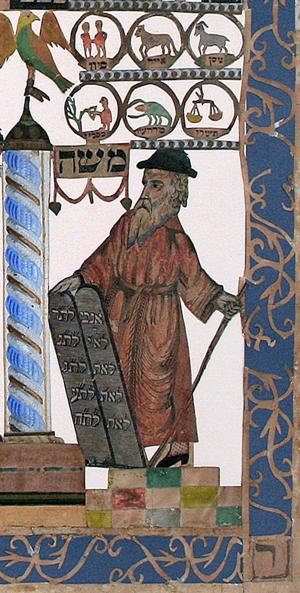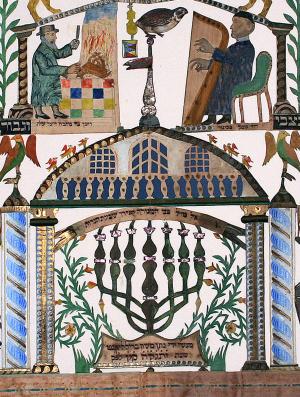Obj. ID: 48922
Hebrew Illuminated Manuscripts Papercut, Lithuania, 1877/78

The following description was prepared by William Gross:
Papercutting or paper cutting is the art of cutting paper designs. The German term for the art form, Scherenschnitte, which means "scissor cuts", describes one of the techniques for cutting, the other being the use of a very sharp knife with the paper on a board. The art work often has symmetry within the design, and common forms include silhouettes and all sorts of wall plaques. The art has evolved uniquely all over the world to adapt to different cultural styles. The oldest examples are from China of the 6th century. By the eighth or ninth century papercutting appeared in West Asia and in Turkey in the 16th century. Within another century, papercutting was being done in most of middle Europe.
Papercutting has been a Jewish art form since the 17rh century, connected with various customs and ceremonies and associated with holidays and family life, although today the earliest surviving examples are from the 18th century. Paper cuts are often decorated Ketubot (marriage contracts), Mizrachs, and other ornamental plaques for Feztive occasions. From the 18th century papercutting had become a popular form for small religious artifacts such as Mizrachs and Shavuot decorations. In the 20th century, the art of Jewish papercutting was revived in Israel. Today it is most commonly used for Mizrachs and Ketubot.
One of the larger and more elaborate existing Jewish papercuts, this example is made as a Mizrach for designation of the Eastern wall, the direction to Jerusalem and the direction of prayer. There are many images depicted, including Moses, Aaron, David and Noah. In addition to the Biblical figures there are the Temple menorah, the Temple pillars, birds, a deer, lions and eagles. Most unusual for are the delicately cut-out signs of the zodiac. In addition to the normal cutout technique used, this work carries figures and shapes cut from printed publications that are pasted on to the page. These images are adentical to figures on a series of Simchat Torah flags printed by the firm of Romm in Vilna in 1872, also in the Gross Family Collection. They were cut out from the flags and pasted on the art work, slightly modified in some instances and hand colored. This most probably places the origin of the papercut in the area of Lithania. Other sections are painted with gouache colors. Numerous inscriptions, some from the Bible, are written. The artist's name, Matan Moshe Brilliant, and the date, 1877/1878 are recorded in a colophon at the bottom. One of the characteristics of most Jewish papercuts is that they were constructed from very cheap paper. Such material deteriorated quickly from exposure to light; this fact accounts for the rarity of such objects
sub-set tree:
A | Animals, the Four (Mishnah, Avot, 5:20) | Lion (of the Four Animals)
O | Ornamentation: | Full page framed
G | Griffin
E | Emblem | Emblems of houses in Judengasse of Frankfurt | Hirsch (Deer)
O | Ornamentation: | Foliate and floral ornaments | Floral motif
|






